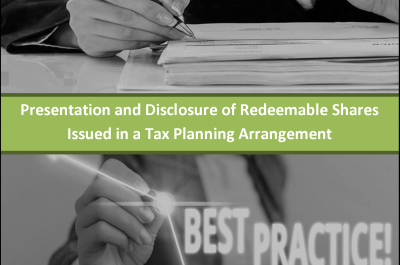Working through the adoption of the new requirements under HB 3856 Financial Instruments for the measurement, presentation and disclosure of redeemable shares issued in a tax planning arrangement is well underway for December 31, 2021, year-ends.
If your experience is similar to ours, you have likely found that a significant proportion of the outstanding redeemable shares will be reclassified to liabilities at the full redemption amount (except for where the pre-January 2018 issuance transition exemption is applied). Once the financial statements are updated to include the required presentation and disclosure under the amended standards including all related changes to financial instruments and share capital disclosures, we are left with one outstanding question. Current or long-term?
To receive the preferential tax treatment under the Income Tax Act, redeemable shares issued under a tax planning arrangement are generally required to be due on demand. Therefore, it is expected that these would be presented as current liabilities, unless there is an arrangement, such as a redemption schedule, that would indicate otherwise. Please note that the callable debt presentation, as provided in the illustrative example in HB 1510 Current Assets and Current Liabilities, is not permitted to be used for redeemable shares.
It has been our experience to date, that many entities do not have planned redemption schedules in place, as the shares are redeemed at points in time when it does not negatively impact the entity to do so. In absence of a redemption schedule there would need to be supporting documentation provided in the engagement file for presentation as a long-term liability, either in whole or in part.
This documentation may be in the form of redemption restrictions set out in lending agreements or formalized shareholders agreements, or perhaps a formal waiver from calling redemptions over the coming year. Remember that the existence of a waiver, without supporting evidence that it is effective (ie. Redemption waived year after year with annual redemptions triggered), will not be sufficient evidence to provide for long-term presentation.
Visit our online store if you are looking for resources:
- a guide to provide you with examples of financial statement measurement, presentation and disclosures for redeemable shares;
- draft memorandum to file to support the adoption and related elections under HB 3856 amendments; or
- a modifiable sample wavier of redemption of redeemable shares.
If there are other resources or information you are looking for, contact us for assistance.
